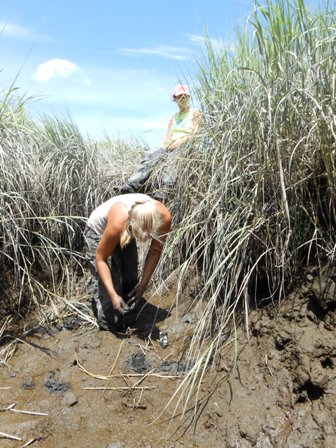As a highly productive ecosystem, salt marshes are known for their diverse range of primary producers that can support a whole host of organisms, from microscopic invertebrates to large fish. Fertilization of the tidal creeks results in a large increase in benthic microalgae, which is a main food source for primary consumers (benthic invertebrates). The predominant secondary consumer in this system is the mummichog (Fundulus heteroclitus), which feeds on both the benthic microalgae and the primary consumer invertebrates.
In recent years, however, decreases in mummichog densities have been observed in the fertilized tidal creeks—an unexpected occurrence in the face of such an apparent abundance of food. Classic bottom-up theory of food web control predicts that increased primary production stimulates productivity at all higher trophic levels. In this case, however, it seems that bottom-up control may be attenuated if nutrients stimulate inedible or inaccessible herbivores, which can end up dominating the primary consumer community. This phenomenon is the idea of a trophic bottleneck. If the majority of primary production is consumed by inedible herbivores (snails with large, tough shells) or inaccessible herbivores (high marsh invertebrates), secondary consumers can’t access that energy and are at a disadvantage.

In order to examine the surface invertebrates, I used to a 0.0625 square meter quadrat to randomly sample at points both in the mud flats and in the high marsh. In the mud flats, I ran a 200 meter transect along the creek bottom and sampled at 20 random points along that line. In the high marsh, I sampled at 10 points along the creek banks, where I clipped all the grass away within the quadrat to count and collect the invertebrates. In the lab, I counted all the invertebrates and measured the shell heights of all the high marsh and mudflat snails. Using the counts and measurements, I calculated the densities and biomass of the mudsnails, high marsh snails, amphipods, and isopods.
I sampled for infauna by taking small cores (6.6 cm diameter) from all three habitats. I took 2 replicates in each habitat and did this 3 times for each of the two branches of all the creeks. In the lab, I rinsed and sieved these cores before storing them in formalin to process throughout the fall. I’ll be comparing my 2012 infauna results to infauna data from 2009, which I also processed this summer, using a microscope to count and identify the different annelid species. In addition, I will examine my early season and late season data to measure growth throughout the summer. By comparing the primary consumer communities between fertilized and reference creeks, I hope to determine whether nutrient enrichment is causing a trophic bottleneck in this salt marsh food web.
Leave a Reply